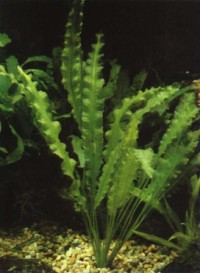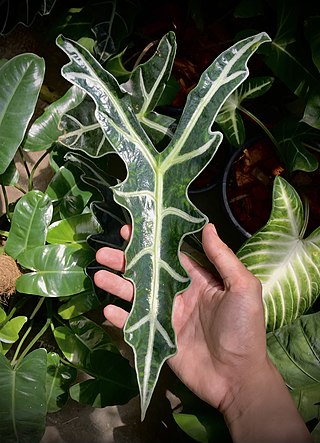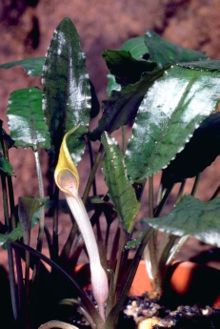Description
Cryptocoryne beckettii is a perennial, rhizomatous, herb that can grow as an emergent or as a submerged aquatic. It has basal leaves with elongate, sheathing petioles up to 15 cm (6 in) long. The blades are glabrous, ovate to narrowly ovate, 3 to 9 cm (1.2 to 3.5 in) long and 1 to 3.5 cm (0.39 to 1.38 in) wide. The blade's upper surface is green to dark green or brown and marbled to red-brown, and the lower surface is generally red-tinged, to more or less brownish or green. The leaves have an acute to acuminate apex, entire or sometimes undulate leaf margins, and conspicuously red veins. Submerged plants usually have larger, thinner leaves. The rarely seen inflorescences are short-peduncled with a 4-to-12-centimetre-long (1.6 to 4.7 in) spathe. The greenish-brown limb is twisted, upright to somewhat recurved, and narrowly ovate in shape, generally 0.5 to 1.2 cm (0.20 to 0.47 in) wide and 1.5–3 cm (0.59–1.18 in) long. The spadix is typically 1.0 cm (0.39 in) long (Rosen, 2000).
- Rosen, D.J. 2000. Cryptocoryne beckettii (Araceae), a new aquatic plant in Texas. Sida 19(2): 399-401.

Cryptocoryne is a genus of aquatic plants from the family Araceae. The genus is naturally distributed in tropical regions of India, Southeast Asia and New Guinea.

Anubias is a genus of aquatic and semi-aquatic flowering plants in the family Araceae, native to tropical central and western Africa. They primarily grow in rivers and streams, but can also be found in marshes. They are characterized by broad, thick, dark leaves that come in many different forms. The genus was revised in 1979 and since then its nomenclature has been stable. Species can be determined by using mostly characteristics of the inflorescence. Because of the often shady places where the plants grow, the genus was named after the Egyptian god Anubis, the god of the afterlife. The genus was first described in 1857 by Heinrich Wilhelm Schott, with A. afzelii as its type species.

Echinodorus cordifolius, the spade-leaf sword or creeping burhead, is a species of aquatic plants in the Alismatales. It is native to Mexico, the West Indies, Central America, South America and the southeastern United States.

Aponogeton distachyos or Aponogeton distachyum, also known as waterblommetjie, Cape-pondweed, water hawthorn, vleikos and Cape pond weed is an aquatic flowering plant.

Echinodorus macrophyllus is a species of aquatic plants in the Alismataceae. It is native to Brazil and Bolivia.

Echinodorus uruguayensis or Echinodorus osiris is a plant species in the Alismataceae. It is native to South America.

Echinodorus berteroi is an aquatic plant species in the Alismataceae It is native to the southern and central parts of the United States, as well as Central America, the West Indies, and South America as far south as Argentina.

Aponogeton crispus is an aquatic plant species.

Alocasia sanderiana, commonly known as the kris plant or Sander's alocasia, is a plant in the family Araceae. It is endemic to Northern Mindanao in the Philippines, but is commonly grown as an ornamental plant worldwide. It is classified as critically endangered in the wild by the International Union for Conservation of Nature.

Aponogeton ulvaceus is a submerged aquatic plant in the Aponogetonaceae family. It has a small cone shaped, slightly hairy rhizome about 30 mm in diameter. The leaf blades have a base that tapers gradually, pale green in colour, over 50 cm (20 in) long and 8 cm (3 in) broad, with a wavy margin on petioles of an equal length, and in appearance slightly translucent. A single bulb may produce up to forty leaves in good conditions. No floating leaves are formed. The yellow flowers are produced on one or two, and sometimes more, erect spikes.
Cryptocoryne affinis is a plant species belonging to the Araceae genus Cryptocoryne.
Cryptocoryne undulata, also known as undulate cryptocoryne, is a plant species belonging to the Araceae genus Cryptocoryne.

Cryptocoryne × willisii is a plant in the family Araceae.
Cryptocoryne aponogetifolia is a species belonging to the Araceae genus Cryptocoryne.
Cryptocoryne auriculata is a plant species belonging to the Araceae genus Cryptocoryne.

Ambrosina is a genus in the family Araceae that consists of only one species, Ambrosina bassii, and the only genus in the tribe Ambrosineae. This species is the smallest aroid in the Mediterranean, growing only to 8 cm tall. It is usually found growing in woodlands on north faces of hillsides and in humus soil that is covering limestone. It is distributed in Sardinia, Corsica, Sicily, southern mainland Italy, Tunisia, and Algeria.

Nepenthes andamana is a tropical pitcher plant endemic to Phang Nga Province, Thailand, where it grows near sea level in coastal savannah and grassland. It is thought to be most closely related to N. suratensis.

Podostemum ceratophyllum, commonly known as the hornleaf riverweed, is a species of submerged aquatic plant in the family Podostemaceae. It is native to eastern North America where it grows on hard bottoms in swiftly flowing rivers and streams and is considered a foundation species.

Asclepias perennis, also known as aquatic milkweed or white swamp milkweed, is a North American species of milkweed that is found throughout the Coastal Plain from eastern Texas to southern South Carolina, northward along the Mississippi River, and into the Ohio Valley of Illinois, Indiana, and Kentucky. There seems to be a few disjunct populations in Arkansas, Texas, and Indiana.
Cryptocoryne parva is an aquatic freshwater plant, often grown in aquariums. It is the smallest known member of the genus Cryptocoryne. Native to Sri Lanka, it grows as a small rosette reaching between 5 - 8 cm. Emerse leaves are a little wider than those growing under water. The spathe is c. 1.5 cm.















